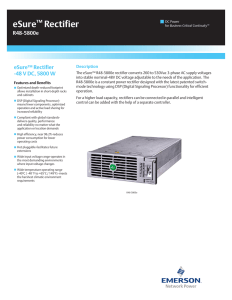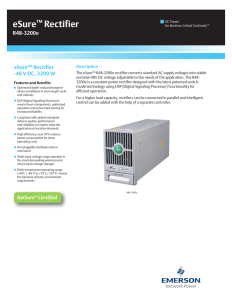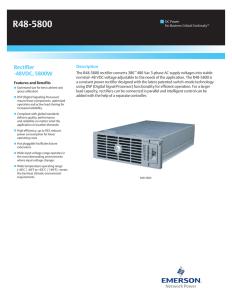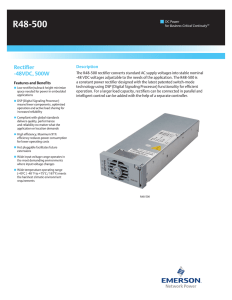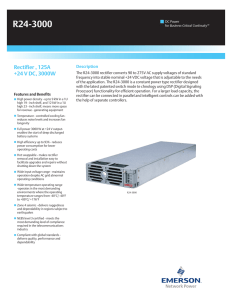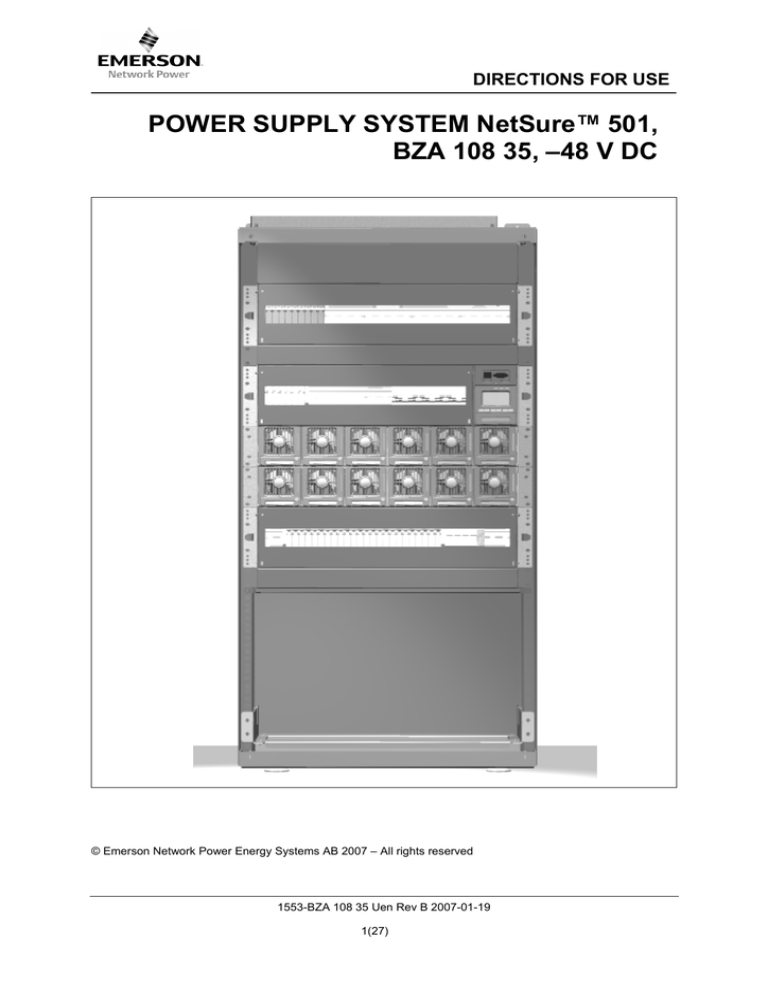
DIRECTIONS FOR USE
POWER SUPPLY SYSTEM NetSure™ 501,
BZA 108 35, –48 V DC
© Emerson Network Power Energy Systems AB 2007 – All rights reserved
1553-BZA 108 35 Uen Rev B 2007-01-19
1(27)
DIRECTIONS FOR USE – BZA 108 35
The contents of this document are subject to revision without notice due
to continued progress in methodology, design, and manufacturing.
Emerson Network Power Energy Systems AB
SE – 141 82 Stockholm
Sweden
Tel. +46 8 721 6000
Fax. +46 8 721 7177
www.emersonenergy.com
1553-BZA 108 35 Uen Rev 2007-01-19
2(27)
DIRECTIONS FOR USE – BZA 108 35
Contents
1
Introduction
4
2
Function
4
3
Configurations
5
4
Units in the system
8
4.1
4.2
4.3
4.4
4.5
4.6
Rectifier
Rectifier subrack
Control units
Multifunction unit
AC distribution
AC connection terminals
8
10
11
11
12
12
5
Technical data
13
5.1
5.2
5.3
System
Cabinet
Rectifier
13
13
13
6
Installation
14
7
Start-up and installation test
14
8
Maintenance
14
8.1
8.2
8.3
8.4
Safety
Scheduled maintenance
Alarms
Fault symptoms and trouble shooting
14
14
15
15
9
Exchange of units and parts
21
9.1
9.2
9.3
9.4
9.5
9.6
9.7
Exchange of rectifiers
Rectifier fan replacement
Exchange of distribution circuit-breaker
Exchange of contactor
Exchange of SCU/ACU
Exchange of connector board
Exchange of SCU/ACU supply fuses
21
22
23
24
25
25
26
10
Abbreviations used in this document
27
1553-BZA 108 35 Uen Rev 2007-01-19
3(27)
DIRECTIONS FOR USE – BZA 108 35
1
Introduction
The NetSure™ 501 –48 V DC power system consists of a stand-alone cabinet,
DC-distribution unit, maximum 12 rectifiers of 1700 W, battery connections
and a supervision unit.
2
Function
For the protection of the batteries during a power outage, the load is disconnected at a preset voltage or after a predetermined delay.
To prolong the service of some loads at a long power outage, the DC distribution is divided into two branches. One is for normal load and one for priority
load, so the disconnection can be made in two steps.
AC Mains
Subrack 2
DU, normal load
6 rect.
Priority Load
~
=
MFU
LVD 1
& ICU
Subrack 1
6 rect.
LVD 2
~
=
Shunt
AC terminals
CAN-bus
Batt.
CBs
SCU/
ACU
Figure 1.
Example of system topology.
1553-BZA 108 35 Uen Rev 2007-01-19
4(27)
Ext. Batts.
DIRECTIONS FOR USE – BZA 108 35
3
Configurations
The cabinets can be configured with different numbers of rectifiers, batteryand distribution- circuit-breakers. They are built for overhead cabling.
Extension
distribution unit
MFU and Control unit
Rectifier subrack
Rectifier subrack
AC distribution
unit (optional)
Figure 2.
Example of configuration with overhead cabling.
1553-BZA 108 35 Uen Rev 2007-01-19
5(27)
DIRECTIONS FOR USE – BZA 108 35
The Figure 3 and Figure 4 give examples of standard configurations.
Cover panel 2 U
AC terminals (if no ACD)
MFU (battery CBs,
S/A
LVDs, normal and
C/C
prio load CBs
U/U
R
R
R
R
R
R
ACD (optional)
(BMG 653 39/21)
Fire trap
Figure 3.
Configuration with single rectifier subrack.
Cover panel 2 U
AC teminals (if no ACD)
Extension distribution CBs
(normal load)
Cover panel 2 U
MFU (battery CBs,
S/A
LVDs, normal and
C/C
prio load CBs)
U/U
R
R
R
R
R
R
R
R
R
R
R
R
ACD (option)
(BMG 653 39/22)
Fire trap
Figure 4.
Configuration with double rectifier subracks.
1553-BZA 108 35 Uen Rev 2007-01-19
6(27)
DIRECTIONS FOR USE – BZA 108 35
Basic configuration:
•
•
•
•
•
Cabinet for overhead cabling
Maximum 12 rectifiers 1700 W
One or two rectifier subracks for maximum 6 rectifiers each
MFU including maximum four battery CBs, distribution CBs, LVD contactors, a standard control unit (SCU) and a battery shunt
AC terminal unit for maximum 12 rectifiers
•
Battery temperature sensor KET 103 06/1
Options:
•
•
•
•
•
•
•
•
•
•
•
Advanced control unit (ACU)
Cables for battery, distribution, earthing and signalling
Cabling materials (lugs, tie wraps, markings)
Internal AC distribution unit for maximum 12 rectifiers
External AC distribution units
Mains cable
Lifting eye bolts SAR 201 080/03
Cabinet anchoring material BMY 107 125/1
AC inlet pull-relief clamps
Room temperature sensor KET 103 06/1
Spare parts
1553-BZA 108 35 Uen Rev 2007-01-19
7(27)
DIRECTIONS FOR USE – BZA 108 35
4
Units in the system
4.1
Rectifier
The rectifier is voltage regulated of a constant power limitation type (1700 W)
and designed to meet the most stringent electrical requirements as well as
demands for high power density (fan cooling). It can work independently of the
control unit, and can share the load actively and control the system voltage.
LEDs
Figure 5.
Rectifier.
4.1.1 LEDs
The front panel has three indicator LEDs. The functions of the LEDs are listed
in the table below.
LED
Power indicator
(green)
Protection indicator (yellow)
Alarm indicator
(red)
Normal
ON
OFF
OFF
Abnormal
Cause of Abnormality
OFF
No AC Mains Supply
Flashing
Rectifier is under control by SCU/ACU
ON
AC input over/undervoltage, PFC
over/undervoltage and overtemperature
Flashing
Communication with SCU/ACU failure
ON
Output overvoltage
Flashing
Fan Failure
1553-BZA 108 35 Uen Rev 2007-01-19
8(27)
DIRECTIONS FOR USE – BZA 108 35
4.1.2 Features
•
Hot swappable. The rectifier is plug-and-play to live inputs and outputs.
•
Active load sharing. The rectifier uses advanced digital active load sharing
technology for minimum load difference between units.
•
Power derating by input voltage. The rectifier will go into power derated
mode if the input AC voltage is too low or too high.
•
Power derating by output load. The rectifier will limit its output power constant when the load exceeds the nominal output power.
•
Power derating by temperature. For high temperatures the output load will
be gradually reduced. See technical data.
•
Current limiting function. The rectifier has a current limiting function. The
current limit can be set from an SCU/ACU.
•
Foldback current limiting function. If a short circuit occurs on the rectifier
output terminals, the rectifier will keep its output current at a constant
value. When the short circuit fault is cleared, the rectifier will automatically
restore to normal operation.
•
Adjustable output voltage. The voltage can be set from an SCU/ACU.
•
Current walk-in. The rectifier can be set from an SCU/ACU to take load
gradually in order to reduce the stress on generators, fuses etc.
•
Fan control. The fan’s speed is controlled according to the rectifier internal
temperature. The fan is stopped completely at low temperature and at
very low or high input voltage.
4.1.3 Digital Signal Processor (DSP)
The rectifier has a built-in advanced DSP that monitors and controls the
operation of the rectifier. The DSP also communicates with an SCU/ACU
through a CAN bus.
•
The rectifier can receive commands such as turning on/off, current walk-in
on/off signal and high voltage alarm reset signal from an SCU/ACU.
•
An SCU/ACU can adjust the output voltage, overvoltage alarm point, current walk-in time and the current limit of the rectifier.
•
The rectifier reports its output voltage, output current, temperature, current
limit setpoint, overvoltage setpoint, on/off status and alarm information to
an SCU/ACU in real time.
•
By querying the DSP, an SCU/ACU can get the following data from the
rectifier: Input voltage, output voltage, output current, current limit setpoint,
temperature of rectifier, and overvoltage setpoint.
1553-BZA 108 35 Uen Rev 2007-01-19
9(27)
DIRECTIONS FOR USE – BZA 108 35
•
By querying the DSP, an SCU/ACU can get the following state information
from the rectifier: On/off, protect (input protect, inner DC bus voltage protect; overtemperature), fault (HVSD, fan failure), thermal derating, AC
derating, AC failure, and unbalance current.
•
An SCU/ACU can get the following unit information from the rectifier: Address, code, date, SW version and HW version.
4.1.4 Protection functions
4.2
•
Input over/undervoltage protection. The rectifier will shut down and its yellow LED will emit light if the input voltage is outside the range 80 to
305 V AC. An alarm will be sent to the SCU/ACU.
•
Output overvoltage protection. If the rectifier output voltage exceeds a limit
that can be set from the SCU/ACU, the rectifier will shut down. If output
over voltage occurs two times within 5 minutes, the rectifier can only be
restarted manually and its red alarm LED will emit light. An alarm will be
sent to the SCU/ACU.
•
Over-temperature protection. The rectifier will limit its power to 50% of
rated output power if its internal temperature is higher than 75 °C. If the internal temperature reaches 80 °C, the rectifier will shut down and its yellow LED will emit light. An alarm will be sent to the SCU/ACU.
The alarm will cease and the rectifier will restart when the temperature becomes normal.
•
Communication failure. At communication failure, the rectifier output voltage is reduced to a default value for protection of the battery. The yellow
LED will flash and alarm will be sent to the SCU/ACU.
•
Fan alarm. The red LED will flash at a fan fault and the rectifier will stop.
•
Unbalance of Rectifier Output Current. When the output current of the rectifiers in a DC power system is unbalanced, the rectifier that outputs unbalanced current will be identified automatically and its yellow LED will
emit light. An alarm will be sent to the SCU/ACU.
Rectifier subrack
Figure 6.
Subrack for six rectifiers.
The rectifier subrack has space for six rectifiers.
1553-BZA 108 35 Uen Rev 2007-01-19
10(27)
DIRECTIONS FOR USE – BZA 108 35
4.3
Control units
The control unit is placed in the multifunction unit. It controls, supervises and
communicates with the other units of the power supply system and manages
alarm handling, etc.
Two control units are available. The standard control unit (SCU) has an LCDdisplay, offers internal supervision and alarm handling, sends external alarm
signals over relays and communicates externally via modem with external
computer-based supervision systems (EEM, for example) that can be implemented for different maintenance activities.
The advanced control unit (ACU) has, in addition to the SCU features, an interface to communicate with supervision modules (SM) for supervision of
existing cabinets, AC mains and batteries, for example. It has a Web interface
for communication with MS Explorer.
For detailed information, refer to USER’S GUIDE 5/1553-BMP 903 050 Uen,
for the ACU and 5/1553-BMP 903 051 Uen, for the SCU.
4.4
Multifunction unit
+ terminals
LVD contactors
CB alarm
board
Connector
board
DIN bar for CBs
Figure 7.
MFU.
The unit combines normal and priority distribution circuit-breakers battery CBs,
a battery shunt (500 A) and one or two load disconnect contactors (125 and
500 A). The control unit (SCU/ACU) and the connector board are also
mounted here.
1553-BZA 108 35 Uen Rev 2007-01-19
11(27)
DIRECTIONS FOR USE – BZA 108 35
4.5
AC distribution
R1--------------------------------------------------------R12
Figure 8.
L1 L2 L3 N PE
Input terminal
AC distribution unit seen from front.
For cabinets with double rectifier subracks, an AC distribution unit is available.
It includes separate circuit breakers for each rectifier.
4.6
AC connection terminals
Figure 9.
Mains terminals.
A unit with maximum four terminal blocks can be delivered for the connection
of totally 12 rectifiers.
1553-BZA 108 35 Uen Rev 2007-01-19
12(27)
DIRECTIONS FOR USE – BZA 108 35
5
Technical data
5.1
System
Nominal DC voltage
–48 V
Maximum output current @ 48 V 212 A (with one rectifier subrack) or
425 A (with two rectifier subracks)
Operational temperature
–5 to +45 °C (with hydraulic magnetic
circuit-breakers)
–5 to +30 °C (with thermal/electro magnetic
circuit-breakers)
5.2
5.3
Storage temperature
–40 to +75 °C
Relative humidity
5 to 90%
Cabinet
Building practice
23”
Height (incl. top cover and feet)
1250, 1650, 1850, 2050 mm
Footprint (with x depth)
400 or 600 x 600 mm
Weight (fully equipped,
without batteries)
maximum 150 kg
Rectifier
See data sheet EN/LZT 145 280 RA
1553-BZA 108 35 Uen Rev 2007-01-19
13(27)
DIRECTIONS FOR USE – BZA 108 35
6
Installation
See INSTALLATION INSTRUCTIONS 1531-BZA 108 35 Uen.
7
Start-up and installation test
See TEST INSTRUCTIONS 1532-BZA 108 35 Uen.
8
Maintenance
Adequate knowledge of the power supply system is required. Refer to item 1
to 5 of this document.
8.1
Safety
The document SAFETY RULES 1550-1004 and local safety rules shall be followed when doing maintenance work in the power supply equipment. Measures that require work inside the cabinets or intervention in a unit shall always
be carried out by adequately trained personnel with adequate knowledge of
the power supply system. When in doubt about an action or how to carry it out,
always call for adequately trained personnel.
In case it is necessary to work on a live power supply system, the approval for
this type of work must be given, based on local regulations governing for example the following areas:
8.2
•
General rules for work on live equipment
•
Certification of operatives conducted by certified supervisor
•
Approved tools
•
Customer approval
Scheduled maintenance
•
Use a vacuum cleaner to remove dust from the air inlets of the cabinets.
•
Check and test the batteries according to the recommendations of the battery supplier.
•
A scheduled performance test according to the following table shall be
performed at least every two years according to item “Test of signals and
supervision” in the document TEST INSTRUCTIONS
1532-BZA 108 35 Uen. Settings according to the document TABLE OF
SET VALUES, shall be verified in this test.
A copy of the test result shall be kept in the logbook of the plant.
1553-BZA 108 35 Uen Rev 2007-01-19
14(27)
DIRECTIONS FOR USE – BZA 108 35
8.3
Alarms
8.3.1 Alarm categories
The different alarm categories used in the power supply system are Critical,
Major, Observation and No Alarm.
An alarm of category Critical requires immediate action, whatever the time of
day or night.
An alarm of category Major requires immediate action if it occurs during working-hours, otherwise as soon as the working-hours commence.
An alarm of category Observation is an alarm that indicates a temporary state
of operation and does not normally require any action. However, if the alarm
persists for more than 20 hours, it must be investigated.
If an alarm has category No Alarm it means that the alarm is deactivated and
will not be shown in the display of the SCU/ACU.
8.3.2 Procedure in case of alarm
Enter in the logbook of the power supply system all observations made at the
moment of failure, such as date, time, system voltage and rectifier load. Enter
also what alarm(s) are shown and any external disturbance such as thunderstorm or mains failure.
Trace activated alarms by means of the alarm survey of the respective unit
and the item, which describes what actions to take on the respective alarm.
8.4
Fault symptoms and trouble shooting
8.4.1 System alarms
For system alarms, see USER’S GUIDE 1553-BMP 903 051 Uen for the SCU
and 1553-BMP 903 050 Uen for the ACU.
Alarm on
the SCU
display
Alarm on
the ACU
display
Cause
Suggestion
The outgoing alarms are Check why before reconnecting the alarms.
blocked from the
SCU/ACU.
Alarms
Blocked
Alarm
Blocked
Load Fuse
Alarm
Fuse Alarm One or more distribution
circuit-breakers for the
load have tripped.
Rect Not
Respond
CAN
Comm
Fault
There CAN communication is broken.
Find out and eliminate the reason for the
tripped circuit breaker before resetting it.
Check the connectors and cables for the CAN
loop.
Exchange the rectifier that does not respond.
Exchange the SCU/ACU.
1553-BZA 108 35 Uen Rev 2007-01-19
15(27)
DIRECTIONS FOR USE – BZA 108 35
Alarm on
the SCU
display
LVD 1
LVD 2
Alarm on
the ACU
display
LVD 1 Disconnected
LVD 2 Disconnected
LVD 1/ LVD Contactor
2 Open
Fault
Cause
Suggestion
The contactor for the normal load is open because
the battery is too deep
discharged.
The batteries are disconnected at a preset level, in
order to protect them from
over-discharging.
If there is a mains failure, check that it is not
caused by broken supply fuses.
The contactor for the prioritised load is open because the battery is too
deep discharged.
See LVD 1
An LVD contactor is in a
wrong state.
Check the contactor functions.
If the rectifiers are working, the problem may
be that the system load is higher than the
rectifier capacity, causing the batteries to
discharge. If this is the reason, install more
rectifiers.
Batt Curr
High
Abnorm Bat The boost charging curCurr
rent exceeds the set max.
value.
Check the settings.
Batt Fuse
Alarm
Fuse Alarm
Indicates that one or more
battery fuses/circuit breakers have blown/tripped or
been removed.
If a battery fuse/circuit breaker has been
removed/tripped manually, check with the
person that removed/tripped it before reinserting/resetting it. Ensure that there is no
fault before doing that. The battery fuse
shall be reinserted by adequately trained
personnel.
If the battery fuse/circuit
breaker is blown/tripped,
the reason for the failure
probably is overload or
short circuit.
Find out and eliminate the reason for the
blown/tripped fuse/circuit breaker before
swapping/resetting it.
Exchange the SCU/ACU.
Self-detect
Err
ACU fault
SCU/ACU failure.
Manual
Mode
Manual
Mode
The battery monitoring has Check why before resetting it to automatic.
been set to “Manual
mode” in the SCU/ACU.
Non-Float
Status
Batt Discharge
The system is not in Float
Charge mode because of:
The boost charge is active.
The boost charge will stop automatically.
The battery test is active.
The discharge test will stop automatically.
The battery test is active.
The discharge test will stop automatically.
There is a mains failure.
Check that it is not caused by broken supply
fuses.
The system load is higher
than the rectifier capacity,
causing the batteries to
discharge.
Install more rectifiers.
1553-BZA 108 35 Uen Rev 2007-01-19
16(27)
DIRECTIONS FOR USE – BZA 108 35
Alarm on
the SCU
display
Curr Discrepancy
Alarm on
the ACU
display
Dis Curr Im
Short Test
Fail
Batt Test
Fail
Cause
Suggestion
Check the batteries.
The currents from two
groups of batteries are not
equal.
Note: There must be two
battery shunts in
the system to activate this function.
The short time battery test Check the batteries.
has failed.
Test Failure
The battery test has failed. Check the float charging level.
Check that the load is lower than the capacity of the rectifiers.
Check the battery according to the recommendations of the supplier.
Volt Discrepancy
Rect Over
Volt
Rectifier overvoltage
Mains Failure
Mains Failure
All rectifiers have stopped. Check if there is a general mains failure.
Check that it is not caused by broken supply
fuses.
Multi-Rect
Alarm
Multi-rect fail Two or more rectifiers
have stopped.
See item 8.4.2
Maintain
Alarm
Maintenance Alrm
The maintenance timer
gives alarm
Check the settings of the Maintenance Time
Delay
Rectifier
Lost
Rectifier
Lost
The SCU/ACU has detected a reduction in the
number of running rectifiers.
See item 8.4.2
If the lost rectifier is to be removed permanently, the alarm must be reset from the
SCU/ACU.
Load share
Alarm
The output current of a
rectifier is outside the average value for all rectifiers.
Check the rectifiers.
Rect HVSD
A rectifier output voltage
was higher than the rectifier HVSD setting and has
shut down.
Check the rectifier HVSD setting.
Rect AC Fail Rect AC
Failure
See item 8.4.2
Replace the rectifier.
AC input voltage outside
the normal range.
See item 8.4.2
Rectifier overtemperature
protection.
See item 8.4.2
Rect Failure Rectifier
Failure
Rectifier failure
See item 8.4.2
Rect Protect Rect Protected
Rectifier protection
See item 8.4.2
Rect Over
Temp
1553-BZA 108 35 Uen Rev 2007-01-19
17(27)
DIRECTIONS FOR USE – BZA 108 35
Alarm on
the SCU
display
Alarm on
the ACU
display
Cause
Suggestion
Rect Fan
Fails
Rect Fan
Fail
Rectifier fan failure.
See item 8.4.2.
Rect Derated
Rect Curr
limit
Rectifier overload.
If the batteries are being recharged, the
The load is higher than the alarm will cease by itself when the battery
rectifier capacity.
voltage has increased to the charging level.
If the system load is higher than the rectifier
capacity, the batteries will discharge. If this
is the reason, install more rectifiers.
If one or more of the rectifiers are out of
order, exchange the faulty rectifiers.
DC Volt
Low#1
Under Vol
The distribution voltage
has dropped below the
preset alarm level, usually
initiated because of mains
failure.
If there is a mains failure, check if some
load could be switched off in order to prolong the operating time of the plant.
If there is a rectifier failure, see item 8.4.2.
If the system load is too high related to the
rectifier capacity, install more rectifiers.
If the batteries are being recharged, the
alarm will cease by itself when the battery
voltage has increased to the charging level.
DC Volt
Low#2
Very Under
Vol
See DC Volt Low#1/DC Under Voltage
The distribution voltage
has dropped below the
preset alarm level, usually
initiated because of mains
failure.
DC Volt
High#1
Over Voltage
The system voltage exceeds the preset level.
Check the set float-, battery- and the overvoltage; if the limits are incorrect, find out
why they have changed and correct them.
DC Volt
High#2
The system voltage exceeds the preset level.
Check the set float-, battery- and the overvoltage; if the limits are incorrect, find out
why they have changed and correct them.
AC Voltage
Low#2
The mains voltage is too
low.
Check the mains voltage.
AC Voltage
Low#1
The mains voltage is too
low.
AC Voltage
High
The mains voltage is too
high.
Low Temp
Temp Alarm /Low Amb
Temp
The temperature on a
temperature sensor exceeds the set value.
Check the settings of the SCU.
See AC Voltage Low#2
Check the mains voltage.
Check the settings of the SCU.
Check the temperature.
Check the settings of the SCU/ACU.
If the temperature is OK, exchange the temperature sensor.
1553-BZA 108 35 Uen Rev 2007-01-19
18(27)
DIRECTIONS FOR USE – BZA 108 35
Alarm on
the SCU
display
Temp High
Alarm
No Temp
Sensor 1 or
2
Alarm on
the ACU
display
Cause
Suggestion
High Temp
Check the battery temperature.
The temperature on a
Check the settings of the SCU/ACU.
battery temperature sensor exceeds the set value. If the temperature is OK, exchange the temperature sensor.
Very hiTemp
The temperature on a
See High Temp alarm.
battery temperature sensor exceeds the set value.
High Amb
Temp
The temperature on a
room temperature sensor
exceeds the set value.
T Sensor
Fault
The temperature sensor
has a fault.
Plan BT
Planned battery test in
progress.
Wait for the test to stop automatically.
AC failure
BT
Mains failure.
See Mains Failure alarm.
Manual BT
Manual battery test in proWait for the test to stop automatically.
gress.
Short Test
Short battery test in progress.
Wait for the test to stop automatically.
Cyclic BC
Cyclic boost charge in
progress.
Wait for the boost charge to stop automatically.
Auto BC
Automatic boost charge in Wait for the boost charge to stop automatiprogress.
cally.
Manual BC
Manual boost charge in
progress.
Check the room temperature.
Check the settings of the ACU.
If the temperature is OK, exchange the temperature sensor.
Check the cable and the connector of the
temperature sensor.
Exchange the temperature sensor.
Wait for the boost charge to stop automatically, or stop it manually.
Charge Pro- The boost charge function The boost charge will be blocked by abnorhibit
is blocked.
mal conditions in the system.
Power Major
Indicates “Promt” alarm
(red LED)
Power Minor
Indicates “Main fail” alarm
(yellow LED)
High Load
Ab load curr
The system load is higher
than the set level.
Check the settings.
Indicate alarms on the
digital inputs 1-6.
Check the equipment connected to the corresponding input.
Over Power
Digital 1 (to
6)
DI 1 to DI 6
1553-BZA 108 35 Uen Rev 2007-01-19
19(27)
DIRECTIONS FOR USE – BZA 108 35
8.4.2 Rectifier
The usual fault symptoms of the rectifier include: power indicator (green) off,
protection indicator (yellow) on, protection indicator (yellow) flashing, alarm indicator (red) on, and alarm indicator (red) flashing.
Symptom
Power indicator (green) off
Cause
Suggestion
No input voltage
Make sure there is input AC voltage
Input fuse/circuit-breaker fault
Replace the fuse with a new one
of the same model or switch on
the circuit-breaker.
AC input voltage outside the normal
range
Check that the AC input voltage
is within normal range
PFC overvoltage
Replace the rectifier
Current sharing function is disabled
Replace the rectifier
Rectifier overtemperature protection, which is caused by:
Protection
indicator (yelRemove the obstacle that block
Fan blocked
low) on
the fan
Ventilation blocked: the inlet or outlet Remove the objects that blocks
blocked
the inlet or outlet
Ambient temperature too high or
rectifier inlet too close to a heater
Remove the heater, lower the
ambient temperature
Rectifier not completely inserted into
the slot
Insert the rectifier properly
Protection
indicator (yel- Rectifier communication failure
low) flashing
Exchange the rectifier for a new
one.
Alarm indicator (red) on
Remove the rectifier from the DC
power system and then reinsert
it. Exchange the rectifier for a
new one if the alarm continues.
Rectifier overvoltage
Alarm indicator (red) flash- Fan not running
ing
Replace the fan
When multiple rectifiers are in parallel connection and the unbalance of current sharing among them is higher than 3 %, check if the communication cables are correctly connected.
If the current sharing is still unsuccessful after the correction, replace the rectifier of which the current sharing is out of range.
1553-BZA 108 35 Uen Rev 2007-01-19
20(27)
DIRECTIONS FOR USE – BZA 108 35
9
Exchange of units and parts
To order spare parts, contact Emerson Network Power Energy Systems AB.
9.1
Exchange of rectifiers
1. Loosen the fixing screw of the handle of the faulty rectifier. The handle will
pop out and release the latch locking the rectifier to the subrack.
Fixing screw
Handle
Figure 10. Rectifier handle.
2. Pull out the rectifier unit and remove it.
3. Make sure the handle of the new rectifier unit is locked in its socket with
the fixing screw.
Latch
Figure 11. Locking latch.
4. Insert the new rectifier unit. Push it into its slot until the latch blocks the
way. The latch is set to block the way with the purpose of charging the
rectifier output filter slowly via a charging circuit, as the DC terminals may
get damaged by a spark at a direct connection.
1553-BZA 108 35 Uen Rev 2007-01-19
21(27)
DIRECTIONS FOR USE – BZA 108 35
5. Loosen the fixing screw of the handle, lift the handle, and the latch will withdraw into the rectifier.
6. Continue to push the rectifier into the slot completely.
7. Push the handle into its socket and fasten the fixing screw to lock the
rectifier. Now the rectifier is fixed to the slot by the latch.
The green LED emits light and the fan will start.
9.2
Rectifier fan replacement
If the fan does not work because it is faulty, exchange it for a new one.
1. Remove the rectifier according to item 9.1.
Fan cable plug
Fixing screw
and fan holder
Fan
Front cover
Fixing screws
Figure 12. Fan replacement.
2. Loosen the three screws fixing the front cover to the chassis.
3. Lift out the front cover from the chassis and observe the orientation of the
fan and its wires.
4. Unplug the power cable of the fan and remove the front cover with the fan.
5. Remove the fan from the front cover by removing its two fixing screws and
holders.
6. Replace the fan and fix it to the front cover with the two screws and holders.
7. Plug the fan power cable back into the corresponding socket.
8. Mount the front cover and fix it with the three screws.
9. Reconnect the rectifier according to item 9.1.
1553-BZA 108 35 Uen Rev 2007-01-19
22(27)
DIRECTIONS FOR USE – BZA 108 35
9.3
Exchange of distribution circuit-breaker
1. Open the distribution unit front.
2. Disconnect the distribution cable from the CB.
3. Loosen the CB fixing screw. See Figure 13.
4. Pull the locking device at the bottom of the faulty CB to release it from the
DIN-rail.
5. Lift the CB to release it from the connecting fork. See Figure 13.
3
CB fixing
screw
2
Figure 13. Releasing a distribution circuit-breaker.
6. Remove the CB according to Figure 14.
connecting fork
Figure 14. Removing a distribution circuit-breaker.
1553-BZA 108 35 Uen Rev 2007-01-19
23(27)
DIRECTIONS FOR USE – BZA 108 35
7. Mount a new CB in the reverse order.
8. Lock the new CB to the DIN-rail and switch it off.
9. Connect the distribution cable to the CB.
10. Mount the front to the distribution unit and fix it with the captive screws.
9.4
Exchange of contactor
Note:
The system has no backup during this work.
Figure 15. Exchange of contactor.
1. Take off metallic bracelets, rings or similar that may cause short circuits in
the equipment. Use insulated tools. Insulate the metal parts close to the
contactor with plastic and tape.
2. Open the connector for the signalling cables connected to the contactor.
3. Remove the plastic cover and two rectifiers placed below the contactor.
4. Use an insulated 13 mm U-socket key to loosen the four fixing nuts of the
contactor.
5. Hold the contactor and remove the four fixing nuts.
6. Pull the contactor straight down and remove it through the space in the
rectifier subrack.
7. Insert the new contactor and fix it with four nuts.
8. Connect the signalling cables to the contactor. If the voltage is OK it
should pull up.
9. Fit the plastic cover and two rectifiers below the contactor.
1553-BZA 108 35 Uen Rev 2007-01-19
24(27)
DIRECTIONS FOR USE – BZA 108 35
9.5
Exchange of SCU/ACU
Note:
An LVD contactor is in it’s OFF- position will reconnect when the
SCU/ACU is removed from a live system.
1. Unlock the control unit by pressing the handle so it pops out and pull out
the control unit from the subrack. See Error! Reference source not
found..
2. Insert the new control unit into the subrack, push it in completely and lock
it by pushing the handle into its socket.
9.6
Exchange of connector board
Connectors
Fixing screw
Figure 16. Connector board.
1. Remove the fixing screw, and then pull out the connector board from the
subrack to access the cable connectors. See Error! Reference source
not found..
Note:
Be careful not to damage the surface mounted components at the back of
the board when pulling it out.
2. Disconnect, insulate and mark the signalling cables connected to the terminals of the connector board.
3. Exchange the connector board for a new one.
4. Connect the signalling cables to the terminals of the new board.
Note:
An LVD contactor is in it’s OFF- position will reconnect when the connector board is reconnected to a live system.
5. Insert the connector board into the subrack, push it in completely and fix it
with a screw.
1553-BZA 108 35 Uen Rev 2007-01-19
25(27)
DIRECTIONS FOR USE – BZA 108 35
9.7
Exchange of SCU/ACU supply fuses
There are two fuses at the back-plane board of the SCU/ACU. See Figure 17.
If the display of the SCU/ACU is “dead”, the upper fuse (2 A) might have
blown.
The lower fuse (4 A) protects the supplies of the contactor coils.
2 A for SCU/ACU
4 A for contactors
Figure 17. Fuses for internal supplies.
1553-BZA 108 35 Uen Rev 2007-01-19
26(27)
DIRECTIONS FOR USE – BZA 108 35
10
Abbreviations used in this document
AC
ACD
ACU
BC
BT
CAN
CB
CENELEC
DC
DI
DSP
DU
EEM
EN
ESD
HVSD
ICU
LAN
LCD
LED
LVD
MFU
PE
PFC
R
SCU
SELV
SM
Alternating Current
AC Distribution
Advanced Supervision Unit
Battery Charge
Battery Test
Controller Area Network
Circuit Breaker
European Committee for Electrotechnical Standardization
Direct Current
Digital Input
Digital Signal Processor
Distribution Unit
Emerson EnergyMaster™
ENERGYMASTER is a registered trademark of
Emerson Network Power Energy Systems AB
European Norm
ElectroStatic Discharge
High Voltage Switch Down
InterConnection Unit
Local Area Network
Liquid Crystal Display
Light Emitting Diode
Low Voltage Disconnect
Multi Function Unit
Protective Earth
Power Factor Controller
Rectifier
Standard Supervision Unit
Safety Extra Low Voltage
Supervision Module
1553-BZA 108 35 Uen Rev 2007-01-19
27(27)

